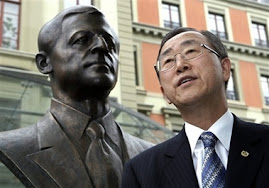A new practical tool to promote human rights education is now available. The new tool, which collects 101 exemplary practices from Central Asia, Europe and North America, is a valuable resource for teachers and education policymakers.
Among the good practices featured in the collection is “Build Bridges, Not Walls”, a Norwegian publication with 97 exercises on human rights, multicultural understanding and peaceful conflict resolution. The exercises, designed for non-formal learning settings such as those involving refugees and immigrants, are already in use in Norway, South-Eastern Europe and Eastern Europe, including conflict areas.
Human rights education is vital for all our societies. “It promotes equality, empowerment and participation as well as conflict prevention and resolution. In brief, it is a means to develop societies where the human rights of all are respected, protected and fulfilled,” said the heads of the four partner organizations in their joint foreword to the collection.
The collection, entitled “Human Rights Education in the School Systems of Europe, Central Asia and North America: A Compendium of Good Practice” , is a joint publication by the Office of the High Commissioner for Human Rights (OHCHR), the Office for Democratic Institutions and Human Rights of the Organization for Security and Co-operation in Europe (OSCE/ODIHR), the Council of Europe (CoE), and the United Nations Educational, Scientific and Cultural Organization (UNESCO).
Designed for primary and secondary schools, teacher training institutions and other learning settings, the this tool collects good practices of human rights education, education for democratic citizenship, and education for mutual respect and understanding.
It provides resource materials relevant to key elements for successful human rights education, including 1) laws, guidelines and standards; 2) learning environment; 3) teaching and learning tools; 4) professional development for educators, and 5) evaluation.
The collection demonstrates creative approaches to human rights education and aims to facilitate networking and exchange of experience among education professionals. The practices can be adapted to local conditions anywhere in the world.
Launched on 2 October in Warsaw, Poland, the collection contributes to the national implementation of the World Programme for Human Rights Education, a global initiative of the UN General Assembly .
2 October 2009
Fonte,http://www.ohchr.org/EN/NewsEvents/Pages/HRsEducationBook.aspx, consultado a 7 de Outubro de 2009.
Among the good practices featured in the collection is “Build Bridges, Not Walls”, a Norwegian publication with 97 exercises on human rights, multicultural understanding and peaceful conflict resolution. The exercises, designed for non-formal learning settings such as those involving refugees and immigrants, are already in use in Norway, South-Eastern Europe and Eastern Europe, including conflict areas.
Human rights education is vital for all our societies. “It promotes equality, empowerment and participation as well as conflict prevention and resolution. In brief, it is a means to develop societies where the human rights of all are respected, protected and fulfilled,” said the heads of the four partner organizations in their joint foreword to the collection.
The collection, entitled “Human Rights Education in the School Systems of Europe, Central Asia and North America: A Compendium of Good Practice” , is a joint publication by the Office of the High Commissioner for Human Rights (OHCHR), the Office for Democratic Institutions and Human Rights of the Organization for Security and Co-operation in Europe (OSCE/ODIHR), the Council of Europe (CoE), and the United Nations Educational, Scientific and Cultural Organization (UNESCO).
Designed for primary and secondary schools, teacher training institutions and other learning settings, the this tool collects good practices of human rights education, education for democratic citizenship, and education for mutual respect and understanding.
It provides resource materials relevant to key elements for successful human rights education, including 1) laws, guidelines and standards; 2) learning environment; 3) teaching and learning tools; 4) professional development for educators, and 5) evaluation.
The collection demonstrates creative approaches to human rights education and aims to facilitate networking and exchange of experience among education professionals. The practices can be adapted to local conditions anywhere in the world.
Launched on 2 October in Warsaw, Poland, the collection contributes to the national implementation of the World Programme for Human Rights Education, a global initiative of the UN General Assembly .
2 October 2009
Fonte,http://www.ohchr.org/EN/NewsEvents/Pages/HRsEducationBook.aspx, consultado a 7 de Outubro de 2009.





